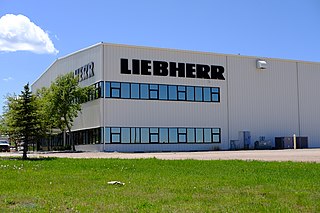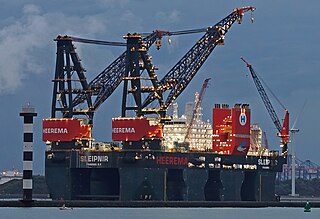
A crane is a machine used to move materials both vertically and horizontally, utilizing a system of a boom, hoist, wire ropes or chains, and sheaves for lifting and relocating heavy objects within the swing of its boom. The device uses one or more simple machines, such as the lever and pulley, to create mechanical advantage to do its work. Cranes are commonly employed in transportation for the loading and unloading of freight, in construction for the movement of materials, and in manufacturing for the assembling of heavy equipment.

A dragline excavator is a heavy-duty excavator used in civil engineering and surface mining. It was invented in 1904, and presented an immediate challenge to the steam shovel (and its diesel and electric powered descendant, the power shovel. Much more efficient than even the largest of the latter, it enjoyed a heyday in extreme size for most of the 20th century, first becoming challenged by more efficient rotary excavators in the 1950s, then superseded by them on the upper end from the 1970s on.

A tow truck is a truck used to move disabled, improperly parked, impounded, or otherwise indisposed motor vehicles. This may involve recovering a vehicle damaged in an accident, returning one to a drivable surface in a mishap or inclement weather, or towing or transporting one via flatbed to a repair shop or other location.

A gantry crane is a crane built atop a gantry, which is a structure used to straddle an object or workspace. They can range from enormous "full" gantry cranes, capable of lifting some of the heaviest loads in the world, to small shop cranes, used for tasks such as lifting automobile engines out of vehicles. They are also called portal cranes, the "portal" being the empty space straddled by the gantry.

A landship is a large land vehicle that travels exclusively on land. Its name is meant to distinguish it from vehicles that travel through other mediums such as conventional ships, airships, and spaceships.

A crane vessel, crane ship, crane barge, or floating crane is a ship with a crane specialized in lifting heavy loads, typically exceeding 1,500 t for modern ships. The largest crane vessels are used for offshore construction.

The Euclid Company of Ohio was a manufacturer which specialized in heavy equipment for earthmoving, particularly dump trucks, loaders and wheel tractor-scrapers. It operated in the US from the 1920s to the 1950s, when it was purchased by General Motors. The firm was later bought by Hitachi Construction Machinery.

A self-propelled modular transporter or sometimes self-propelled modular trailer (SPMT) is a platform heavy hauler with a large array of wheels which is an upgraded version of a hydraulic modular trailer. SPMTs are used for transporting massive objects, such as large bridge sections, oil refining equipment, cranes, motors, spacecraft and other objects that are too big or heavy for trucks. Ballast tractors can however provide traction and braking for the SPMTs on inclines and descents.
The Big Blue was a Lampson LTL-1500 Transi-Lift heavy lift crawler crane that collapsed on July 14, 1999, killing three iron workers.

Ruston-Bucyrus Ltd was an engineering company established in 1930 and jointly owned by Ruston & Hornsby based in Lincoln, England, and Bucyrus-Erie based in South Milwaukee, Wisconsin, the latter of which had operational control and into which the excavator manufacturing operation of Ruston & Hornsby was transferred. The Bucyrus company proper, from which the Bucyrus component of the Ruston-Bucyrus name was created, was an American company founded in 1880, in Bucyrus, Ohio.
Manitowoc Cranes is a division of The Manitowoc Company, Inc. Manitowoc Cranes produces five brands of cranes: Grove, National Crane, Shuttlelift, Manitowoc, and Potain. In addition, Manitowoc has two distribution businesses based in the U.S.: Aspen Equipment and MGX Equipment Services.
Tadano Ltd. is the main and largest Japan-based manufacturer of cranes and aerial work platforms, considered one of largest crane manufacturers in the world.

Liebherr is a German-Swiss multinational equipment manufacturer based in Bulle, Switzerland, with its main production facilities and origins in Germany.
American Crane Corporation is an American manufacturer of construction cranes based in Wilmington, North Carolina. It manufacturers lattice boom crawler cranes with capacities ranging from 50 to 275 tons. The American Crane Corporation was founded in 1882 as the Franklin Manufacturing Company, and in 1892 the name changed to American Hoist & Derrick. The company manufacturers terrain cranes, crawler cranes and tower cranes. In 1998 American Crane Corporation was acquired by Terex for $27 million. The purchase of American Crane Corporation brought Terex a manufacturer of lattice boom cranes.
Sarens is a Belgian multinational company headquartered in Wolvertem, Belgium. Its business includes, heavy lift, engineered transport, and crane rental services. It produces a variety of equipment including cranes, transportation, gantries, jacking products, and other heavy lifting products.

A ring crane is a form of large construction crane with a luffing jib. It is distinguished by its slew pivot being in the form of a ring-shaped track, rather than a narrow central spindle. The broad base this gives to the slewing section above allows it to slew whilst carrying extremely heavy loads.

SSCV Sleipnir is a semi-submersible crane vessel (SSCV) owned and operated by Heerema Marine Contractors. It is named for Sleipnir, the eight-legged horse ridden by Odin in Norse mythology. The vessel is equipped with two revolving cranes built by Huisman Equipment B.V., each with a capacity of 10,000 t ; the main cranes can be operated in tandem to jointly lift 20,000 t. It was ordered in 2015 and built in Singapore by Sembcorp Marine. After its completion in 2019, SSCV Sleipnir succeeded Heerema's earlier SSCV Thialf as the largest crane vessel in the world.

A hydraulic modular trailer (HMT) is a special platform trailer unit which feature swing axles, hydraulic suspension, independently steerable axles, two or more axle rows, compatible to join two or more units longitudinally and laterally and uses power pack unit (PPU) to steer and adjust height. These trailer units are used to transport oversized load, which are difficult to disassemble and are overweight. These trailers are manufactured using high tensile steel, which makes it possible to bear the weight of the load with the help of one or more ballast tractors which push and pull these units via drawbar or gooseneck this combination of tractor and trailer is also termed as heavy hauler.

Faymonville Group is a trailer and heavy transport equipment manufacturer operating worldwide. Started back in the 1960s in Rocherath, Belgium as a blacksmith shop later started to manufacture and sell agriculture machines and tractor cabins in 1962 opened a new production unit to fulfill the demand of forestry vehicles. In the late 1960s, the company manufactured its first semi-trailer. Today it manufactures every type of trailer for different transportation needs, ranging from flatbeds to SPMTs. With 4 production facilities spread around Europe in Luxembourg, Belgium, Poland and Italy while having its headquarters in Luxembourg.
The XGC88000 crawler crane is class of extremely large ultraheavy crawler crane made by XCMG. With a lifting capacity of 3,600 to 4,000 tons, a total boom length of 144 meters and a total gross weight of 5,350 tons. The XGC88000 crawler crane became the largest tracked mobile crane in the world, beating out the previous record holder, the Liebherr LR 13000 when it officially came into production in 2013. However, when it comes to absolute size, movability, and strength, the title still goes to the Honghai Crane which runs on rails.














